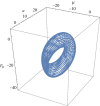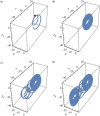Free energy and inference in living systems
- PMID: 37065269
- PMCID: PMC10102732
- DOI: 10.1098/rsfs.2022.0041
Free energy and inference in living systems
Abstract
Organisms are non-equilibrium, stationary systems self-organized via spontaneous symmetry breaking and undergoing metabolic cycles with broken detailed balance in the environment. The thermodynamic free-energy (FE) principle describes an organism's homeostasis as the regulation of biochemical work constrained by the physical FE cost. By contrast, recent research in neuroscience and theoretical biology explains a higher organism's homeostasis and allostasis as Bayesian inference facilitated by the informational FE. As an integrated approach to living systems, this study presents an FE minimization theory overarching the essential features of both the thermodynamic and neuroscientific FE principles. Our results reveal that the perception and action of animals result from active inference entailed by FE minimization in the brain, and the brain operates as a Schrödinger's machine conducting the neural mechanics of minimizing sensory uncertainty. A parsimonious model suggests that the Bayesian brain develops the optimal trajectories in neural manifolds and induces a dynamic bifurcation between neural attractors in the process of active inference.
Keywords: Bayesian brain; Schrödinger’s machine; free-energy principle; homeostasis and allostasis; living system; neural attractor.
© 2023 The Authors.
Conflict of interest statement
I declare I have no competing interests.
Figures





Similar articles
-
I like therefore I can, and I can therefore I like: the role of self-efficacy and affect in active inference of allostasis.Front Neural Circuits. 2024 Jan 22;18:1283372. doi: 10.3389/fncir.2024.1283372. eCollection 2024. Front Neural Circuits. 2024. PMID: 38322807 Free PMC article.
-
Morphogenesis as Bayesian inference: A variational approach to pattern formation and control in complex biological systems.Phys Life Rev. 2020 Jul;33:88-108. doi: 10.1016/j.plrev.2019.06.001. Epub 2019 Jun 12. Phys Life Rev. 2020. PMID: 31320316 Review.
-
Bayesian mechanics for stationary processes.Proc Math Phys Eng Sci. 2021 Dec;477(2256):20210518. doi: 10.1098/rspa.2021.0518. Epub 2021 Dec 8. Proc Math Phys Eng Sci. 2021. PMID: 35153603 Free PMC article.
-
Recognition Dynamics in the Brain under the Free Energy Principle.Neural Comput. 2018 Oct;30(10):2616-2659. doi: 10.1162/neco_a_01115. Epub 2018 Jul 18. Neural Comput. 2018. PMID: 30021085
-
The Markov blanket trick: On the scope of the free energy principle and active inference.Phys Life Rev. 2021 Dec;39:49-72. doi: 10.1016/j.plrev.2021.09.001. Epub 2021 Sep 14. Phys Life Rev. 2021. PMID: 34563472 Review.
References
-
- Fang X, Kruse K, Lu T, Wang J. 2019. Nonequilibrium physics in biology. Rev. Mod. Phys. 91, 045004. (10.1103/RevModPhys.91.045004) - DOI
-
- Goldenfeld N, Woese C. 2011. Life is physics: evolution as a collective phenomenon far from equilibrium. Annu. Rev. Condens. Matter Phys. 2, 375-399. (10.1146/annurev-conmatphys-062910-140509) - DOI
-
- Ivanitskii GR. 2010. 21st century: what is life from the perspective of physics? Phys. Usp. 53, 327-356. (10.3367/UFNe.0180.201004a.0337) - DOI
LinkOut - more resources
Full Text Sources
Research Materials

